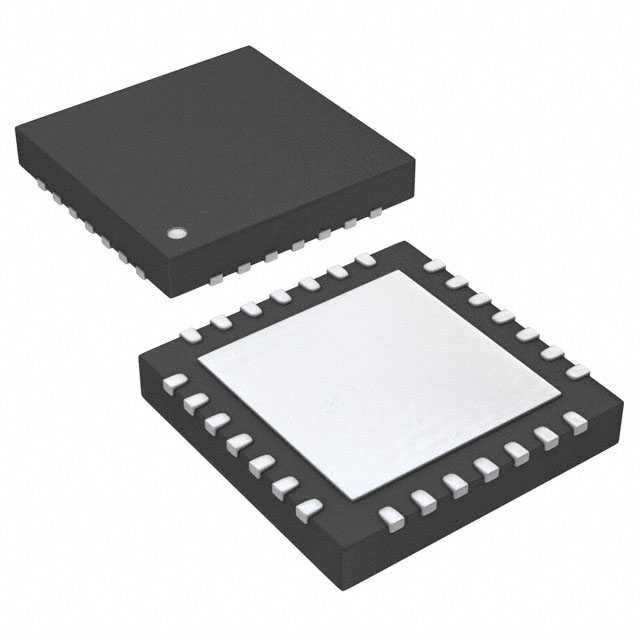PIC16F1826-I/MV
Product Overview
Category
The PIC16F1826-I/MV belongs to the category of microcontrollers.
Use
This microcontroller is commonly used in various electronic applications that require embedded control and processing capabilities.
Characteristics
- Low power consumption
- High performance
- Enhanced peripheral integration
- Flexible I/O options
- Wide operating voltage range
Package
The PIC16F1826-I/MV is available in a compact and durable package, making it suitable for use in space-constrained environments.
Essence
The essence of the PIC16F1826-I/MV lies in its ability to provide efficient and reliable control and processing capabilities in a small form factor.
Packaging/Quantity
This microcontroller is typically packaged in reels or tubes, with varying quantities depending on the manufacturer's specifications.
Specifications
- Architecture: 8-bit
- CPU Speed: Up to 32 MHz
- Program Memory Size: 14 KB
- RAM Size: 1.5 KB
- Number of I/O Pins: 18
- ADC Channels: 10-bit, 9 channels
- Communication Interfaces: UART, SPI, I2C
- Operating Voltage Range: 2.3V to 5.5V
- Temperature Range: -40°C to +125°C
Detailed Pin Configuration
The PIC16F1826-I/MV features 18 I/O pins, each serving a specific purpose. The pin configuration is as follows:
- RA0 - Analog Input / Digital I/O
- RA1 - Analog Input / Digital I/O
- RA2 - Analog Input / Digital I/O
- RA3 - Analog Input / Digital I/O
- RA4 - Analog Input / Digital I/O
- RA5 - Analog Input / Digital I/O
- RE0 - Digital I/O
- RE1 - Digital I/O
- RE2 - Digital I/O
- VSS - Ground
- VDD - Power Supply
- RB0 - Digital I/O
- RB1 - Digital I/O
- RB2 - Digital I/O
- RB3 - Digital I/O
- RB4 - Digital I/O
- RB5 - Digital I/O
- RB6 - Digital I/O
Functional Features
- Enhanced Capture/Compare/PWM (CCP) module for precise timing and control
- Integrated Analog-to-Digital Converter (ADC) for accurate analog signal processing
- Multiple communication interfaces for seamless data exchange
- Timers and counters for event tracking and synchronization
- Interrupt capability for efficient multitasking
- Low-power modes for energy-efficient operation
Advantages and Disadvantages
Advantages
- Compact size allows for easy integration into space-constrained designs
- Wide operating voltage range enables compatibility with various power sources
- Enhanced peripheral integration reduces the need for external components
- Low power consumption prolongs battery life in portable applications
Disadvantages
- Limited program memory size may restrict the complexity of certain applications
- Relatively small number of I/O pins may limit the connectivity options in larger projects
Working Principles
The PIC16F1826-I/MV operates based on an 8-bit architecture, utilizing a central processing unit (CPU) to execute instructions stored in its program memory. It interacts with external devices through its I/O pins and communicates with other components via the available communication interfaces. The microcontroller's functional features, such as timers, counters, and interrupt capability, enable it to perform various tasks efficiently.
Detailed Application Field Plans
The PIC16F1826-I/MV finds application in a wide range of fields, including but not limited to: - Home automation systems - Industrial control systems - Automotive electronics - Medical devices - Consumer electronics
Detailed and Complete Alternative Models
- PIC16F1826-I/P
- PIC16F1826T-I/ML
- PIC16F1826T-I/MV
- PIC16F1826T-I/SS
These alternative models offer similar functionality and characteristics to the PIC16F1826-I/MV, providing flexibility in choosing the most suitable microcontroller for specific applications.
Word count: 511 words
قم بإدراج 10 أسئلة وإجابات شائعة تتعلق بتطبيق PIC16F1826-I/MV في الحلول التقنية
What is the maximum operating frequency of PIC16F1826-I/MV?
- The maximum operating frequency of PIC16F1826-I/MV is 32 MHz.Can PIC16F1826-I/MV be used for motor control applications?
- Yes, PIC16F1826-I/MV can be used for motor control applications with its integrated PWM modules.Does PIC16F1826-I/MV support analog-to-digital conversion?
- Yes, PIC16F1826-I/MV has a 10-bit ADC module for analog-to-digital conversion.What communication interfaces are supported by PIC16F1826-I/MV?
- PIC16F1826-I/MV supports SPI, I2C, and UART communication interfaces.Is PIC16F1826-I/MV suitable for battery-powered applications?
- Yes, PIC16F1826-I/MV is suitable for battery-powered applications due to its low power consumption features.Can PIC16F1826-I/MV be programmed using C language?
- Yes, PIC16F1826-I/MV can be programmed using the C language with MPLAB XC8 compiler.What is the flash memory size of PIC16F1826-I/MV?
- PIC16F1826-I/MV has 14 KB of flash memory for program storage.Does PIC16F1826-I/MV have built-in timers?
- Yes, PIC16F1826-I/MV has multiple built-in timers for various timing applications.Can PIC16F1826-I/MV be used in automotive electronics?
- Yes, PIC16F1826-I/MV is suitable for automotive electronics applications with its robust features.What development tools are available for programming PIC16F1826-I/MV?
- Development tools such as MPLAB X IDE and PICkit programmers can be used for programming PIC16F1826-I/MV.


